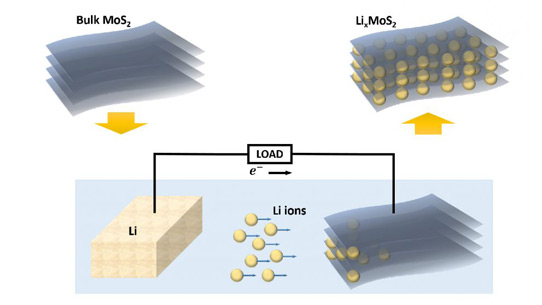- News
21 October 2016
Tuning thermal conductivity of 2D materials to aid heat dissipation in flexible, thin, lightweight electronic devices
A team of researchers at North Carolina State University (NCSU), University of Illinois at Urbana-Champaign (UIUC) and the Toyota Research Institute of North America (TRINA) says that it has found an unexpected way to control the thermal conductivity of two-dimensional (2D) materials, which could allow electronics designers to dissipate heat in electronic devices that use these materials (Gaohua Zhu et al, 'Tuning Thermal Conductivity in Molybdenum Disulfide by Electrochemical Intercalation', Nature Communications; DOI: 10.1038/NCOMMS13211).
Since 2D materials have a layered structure - with each layer having strong bonds horizontally (in plane) and weak bonds between the layers (out of plane) - they have unique electronic and chemical properties, and hold promise for use in creating flexible, thin, lightweight electronic devices. For many of these potential applications, it is important to be able to dissipate heat efficiently. However, this can be tricky. In 2D materials, heat is conducted differently in plane than it is out of plane.
For example, in the transition-metal dichalcogenide (TMD) class of 2D materials, heat is conducted at 100 watts per meter per Kelvin (W/mK) in plane but at only 2W/mK out of plane, giving it a thermal anisotropy ratio of about 50.

Picture: Introducing lithium ions between layers of MoS2 can tune the thermal conductivity of the material.
To better understand the thermal conduction properties of 2D materials, the team began experimenting with the TMD material molybdenum disulfide (MoS2).
The researchers found that, by introducing disorder to the MoS2, they could significantly alter the thermal anisotropy ratio. They created this disorder by introducing lithium ions between the layers of MoS2. Their presence does two things simultaneously: it puts the layers of the 2D material out of alignment with each other, and it forces the MoS2 to rearrange the structure of its component atoms.
When the ratio of lithium ions to MoS2 reached 0.34, the in-plane thermal conductivity was 45W/mK, and the out-of-plane thermal conductivity dropped to 0.4W/mK – increasing the material's thermal anisotropy ratio from 50 to more than 100, i.e. heat became more than twice as likely to travel in plane, along the layer, rather than between the layers.
Adding fewer lithium ions made the thermal anisotropy ratio lower. Adding more ions also made it lower. But in both cases, the ratio was affected in a predictable way, meaning that the researchers could tune the material's thermal conductivity and thermal anisotropy ratio.
"This finding was very counter-intuitive," says Jun Liu, assistant professor of mechanical and aerospace engineering at NC State and co-corresponding author of the paper. "The conventional wisdom has been that introducing disorder to any material would decrease the thermal anisotropy ratio. But, based on our observations, we feel that this approach to controlling thermal conductivity would apply not only to other TMDs, but to 2D materials more broadly," he adds.
"We set out to advance our fundamental understanding of 2D materials," Liu continues. "But we also learned something that is likely to be of practical use for the development of technologies that make use of 2D materials."
NCSU develops new technique for atomic-layer thin-film growth
Metal dichalcogenide heterostructure Molybdenum disulfide NCSU
www.nature.com/articles/ncomms13211


